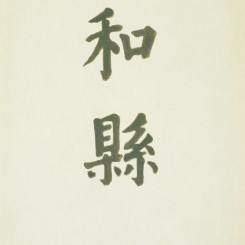Liu Chuanhong Solo Exhibition: Memoir in Southern Anhui
A Thousand Plateaus (Tiexiang Temple Riverfront, High-Tech Development Zone, Chengdu), Sep 20– Nov 30, 2014
Drawings of forests and mountains, biographies of knight-errants, scholars’ notes…such scrolls unfold in Liu Chuanghong’s new series Memoir in Southern Anhui elegantly and steadily, imbued with the pensiveness of the literati all while being rooted in the wilderness that forms the backdrop of so many Chinese tales of chivalry. The works are divided into three acts, with a total of 14 scenes, which include paintings, fabricated “diaries” of ancient scholars, and hand-drawn maps. All of the objects are presented like artifacts and documents in a history museum, laid out in the narrative style of a movie storyboard. The works are a mix of calm and objective texts, elegant Song-style paintings, sepia tones, and the slightly yellowed hue of bygone years—vividly animating this illustrated story of life in Southern Anhui during China’s Republican era (between the fall of the Qing and the Japanese invasion) like an errant gust of wind—here and gone on an unknowable whim….
Ambiguity is the key. Liu Chuanhong has purposely set his countryside story mere decades from the present day, preserving familiar scenes and a humanistic outlook following sweeping industrialization. A wandering scholar living as a hermit in the countryside, the artist uses his boundless imagination to rebuild the chivalrous world of his childhood imaginings within the trappings of his solitary existence. With this escape from the conundrum of reality, the timid, trembling, faithful scholar transforms into a tough and savvy bandit leader, Mr. Liu; he comes to life in the series, stealing from the rich and giving to the poor. As a story of redemption of the human spirit, this exhibition unfolds along similar lines almost like a Chinese film version of Spider Man. The artist has selected a specific time and place against the backdrop of history and transformed himself into a xiake (chivalrous hero)—his invented persona is at times carefree and at other times brutal. The project started as a few whimsical sketches, quietly progressing and leaving a trail of breadcrumbs behind it—scattered scenes left for the audience to piece together with their imaginations. This is the meticulously cared-for realm of Liu Chuanhong’s imagination—an ambiguous and elastic liberated space, an in-between place existing beyond the jurisdiction of contemporary realities. To him, this is high art.
The dissociated, unsure, borderless, undefined, and diverse landscape of contemporary art today has created a realm of the unknown in art and provided a new point of departure. Artists have never had to face the implications of newly discovered virgin territory while the pillars of traditional art theory and rules crumble around them. They face the possibility of choosing versus being chosen; they face the new queries and demands that reality places on art and its artists. As a result, the ones who lack a system of self-worth in their art find themselves at somewhat of a loss; skill and technique are no longer reliable metrics for determining the fundamental properties and value of works of art. Besides their nimble fingers and sensitive visual perception, another essential quality for an artist to have is the cognizance which will allow them to build a system of artistic self-awareness.
Liu Chuanhong seems instinctively aware of this point. In an era when painting no longer seems a sufficient form of expression, he has cleverly avoided a virtuosic style of painting, choosing instead to display a scholar’s literate qualities and knowledge along with a humble rustic lifestyle. He finds a historical access point, referencing traditional Chinese scholarly paintings and drawing on his many years of field research and its accumulated documents to construct an artistic dreamland formed of multiple languages and contexts. Prior to the Memoir in Southern Anhui series, such experimentation could be seen fermenting in past series including Lin Chong Enters Northern Henan, My Friend Xu Wenqiang, and Journey to the West.
Rather than the classic elegance and filmic realism seen in the paintings of faux-scholarly figures scattered throughout Memoir in Southern Anhui, I prefer the vibrant characters appearing as folk prints in the artist’s early series Journey to the West. These are more consistent with the artist’s personal qualities—a literatus who favors the rustic life of a farmer, sowing in spring and harvesting in autumn, wandering the countryside and observing the minutiae of life passing by.

Liu Chuanhong, “Memoir in Southern Anhui, Act II, Scene 6, Hexian 2″, oil on canvas, 43 x 28 cm, 2012–2014
刘传宏,《皖南记事,第二幕第六场,和县2》,布面油画 ,43 × 28cm,2012-2014

Liu Chuanhong, “Memoir in Southern Anhui, Act II, Scene 6, Hexian 4″, oil on canvas, 43 x 28 cm, 2012–2014
刘传宏,《皖南记事,第二幕第六场,和县4》,布面油画 ,43 × 28cm,2012-2014

Liu Chuanhong, “Memoir in Southern Anhui, Act II, Scene 6, Hexian 7″, oil on canvas, 43 x 28 cm, 2012–2014
刘传宏,《皖南记事,第二幕第六场,和县7》,布面油画 ,43 × 28cm,2012-2014


